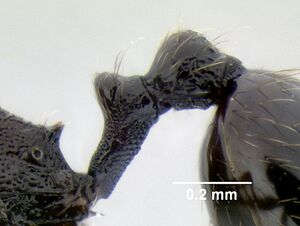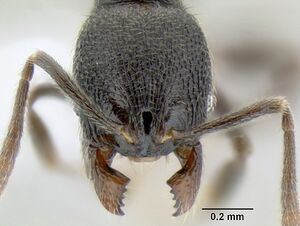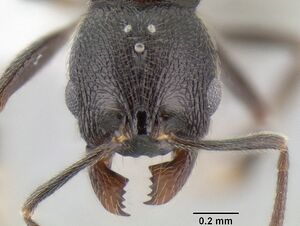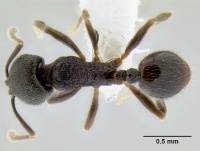Stenamma picopicucha
| Stenamma picopicucha | |
|---|---|

| |
| Scientific classification | |
| Kingdom: | Animalia |
| Phylum: | Arthropoda |
| Class: | Insecta |
| Order: | Hymenoptera |
| Family: | Formicidae |
| Subfamily: | Myrmicinae |
| Tribe: | Stenammini |
| Genus: | Stenamma |
| Species: | S. picopicucha |
| Binomial name | |
| Stenamma picopicucha Branstetter, 2013 | |
Stenamma picopicucha occurs from 1400–2300 m elevation, and is a specialist of montane wet forest habitats, such as cloud forest and dwarf forest. Most collections of this species are from samples of sifted leaf litter taken from the forest floor, but a few specimens are known from cookie bait cards. Nests have never been found, but dealate queens are common in the leaf litter, suggesting that nests might occur within this stratum.
Identification
Branstetter (2013) - Integument mostly dark brown to brown; small-sized species (see HL, ML, PrW below); basal margin of mandible straight, without a basal notch or depression; anterior clypeal margin forming two blunt teeth, which border the midline; face completely sculptured, mostly rugoreticulate; mesosoma completely sculptured, pronotum longitudinally rugose; pilosity on gastral dorsum bilayered, with a layer of long suberect setae, and a layer of very sparse decumbent setae; eye of moderate size (EL 0.10–0.12, REL 17–20), oval-shaped, with 5–6 ommatidia at greatest diameter; propodeal spines tuberculate to short (PSL 0.08–0.10, PSI 1.3–1.6).
Stenamma picopicucha looks like a cross between Stenamma crypticum and Stenamma ignotum. The petiole and anterior clypeal margin are more like S. crypticum, but the basal margin of the mandible and gastral pilosity are more similar to S. ignotum.
Keys including this Species
Distribution
Honduras to Nicaragua.
Latitudinal Distribution Pattern
Latitudinal Range: 15.50739° to 13.5688524°.
| North Temperate |
North Subtropical |
Tropical | South Subtropical |
South Temperate |
- Source: AntMaps
Distribution based on Regional Taxon Lists
Neotropical Region: Honduras (type locality), Nicaragua.
Distribution based on AntMaps
Distribution based on AntWeb specimens
Check data from AntWeb
Countries Occupied
| Number of countries occupied by this species based on AntWiki Regional Taxon Lists. In general, fewer countries occupied indicates a narrower range, while more countries indicates a more widespread species. |

|
Estimated Abundance
| Relative abundance based on number of AntMaps records per species (this species within the purple bar). Fewer records (to the left) indicates a less abundant/encountered species while more records (to the right) indicates more abundant/encountered species. |

|
Biology
Castes
Males have not been collected.
Worker
Images from AntWeb
     
| |
| Worker. Specimen code casent0621347. Photographer Michael Branstetter, uploaded by Default Group. | Owned by MGBPC. |
     
| |
| Holotype Stenamma picopicucha. Worker. Specimen code casent0621356. Photographer Michael Branstetter, uploaded by Default Group. | Owned by USNM. |
     
| |
| Worker. Specimen code casent0622155. Photographer Michael Branstetter, uploaded by Default Group. | Owned by MGBPC. |
     
| |
| Worker. Specimen code casent0622753. Photographer Michael Branstetter, uploaded by Default Group. | Owned by MGBPC. |
 
| |
| Worker. Specimen code casent0606709. Photographer Michael Branstetter, uploaded by Default Group. | Owned by MGBPC. |
Queen
Images from AntWeb
   
| |
| Paratype Stenamma picopicucha. Queen (alate/dealate). Specimen code casent0621374. Photographer Michael Branstetter, uploaded by Default Group. | Owned by USNM. |
Nomenclature
The following information is derived from Barry Bolton's Online Catalogue of the Ants of the World.
- picopicucha. Stenamma picopicucha Branstetter, 2013: 220, figs. 142-144 (w.q.) HONDURAS, NICARAGUA.
- Type-material: holotype worker, 16 paratype workers, 1 paratype queen.
- Type-locality: holotype Honduras: Olancho, 11 km. N Catacamas, 14.94839°N, 85.91477°W±20m., 2020 m., 8.v.2010, LLAMA Wa-C-02-1-03; paratypes: 14 workers with same data, 2 workers, 1 queen with same data but 14.94879°N, 85.91486°W±20m., LLAMA Wa-C-02-1-12.
- Type-depositories: USNM (holotype); CASC, CFSS, EAPZ, FMNH, ICNB, INBC, JTLC, LACM, MCZC, MGBC, MZSP, UCDC, UNAM, USNM, UVGC (paratypes).
- Distribution: Honduras, Nicaragua.
Unless otherwise noted the text for the remainder of this section is reported from the publication that includes the original description.
Description
Worker
(11 measured) HL 0.59–0.69 (0.69), HW 0.52–0.64 (0.64), FLD 0.14–0.15 (0.15), PCW 0.03–0.05 (0.05), SL 0.46–0.55 (0.55), EL 0.10–0.12 (0.12), ACL 0.45–0.53 (0.53), ML 0.71–0.84 (0.84), PrW 0.37–0.42 (0.42), PSL 0.08–0.10 (0.09), SDL 0.06–0.07 (0.07), PL 0.25–0.30 (0.30), PH 0.16–0.19 (0.19), PW 0.13–0.15 (0.15), PPL 0.14–0.18 (0.18), PPH 0.16–0.18 (0.18), PPW 0.16–0.19 (0.19), MFL 0.48–0.59 (0.59), MTL 0.41–0.51 (0.51), CI 89–94 (93), SI 85–89 (86), REL 17–20 (18), FLI 23–28 (23), PSI 1.3–1.6 (1.5), MFI 104–109 (108), ACI1 67–70 (69), ACI2 96–101 (96).
Small-sized species; general body color mostly dark brown to brown, with appendages brown to orange-brown, lighter at joints and toward extremities; setae golden brown; mandible with 6 teeth, inner two teeth near basal tooth, sometimes worn; basal margin of mandible straight, without a basal notch or depression; mandible surface mostly smooth, with scattered piligerous punctae and some faint striations on base and lateral surface; anterior clypeal margin forming 2 blunt teeth, which border the midline; median lobe of clypeus with a pair of faint longitudinal carinulae, which diverge anteriorly, apex of lobe with a short transverse carinula, area in between lobe and anterior clypeal margin forming a distinct cavity, remainder of clypeal surface smooth; posterior extension of clypeus between antennal insertions of moderate width (PCW 0.03–0.05), with sides subparallel; frontal lobes of moderate width (FLD 0.14–0.15, FLI 24–28), not greatly covering torular lobes in full-face view; head subrectangular (CI 89–94), posterior margin with a slight median depression; eye of moderate size (EL 0.10–0.12 , REL 17–20), oval-shaped, with 5–7 ommatidia at greatest diameter; face mostly rugoreticulate, with some longitudinal carinulae along midline; scape somewhat short (SI 85–89), not quite reaching posterior margin of head when laid back; scape surface mostly smooth, with scattered piligerous punctae; flagellum with a somewhat distinct 4-segmented antennal club; mesosoma completely sculptured; pronotal dorsum longitudinally rugose, becoming rugoreticulate-punctae on mesono tal dorsum; side of pronotum rugose to rugose-punctate; katepisternum and side of propodeum mostly punctate, with a few rugulae on propodeum; propodeal dorsum mostly punctate, with a few transverse carinulae; propodeal declivity with transverse carinulae; promesonotum in profile slightly asymmetrical, with the anterior face long and steeper than posterior face; metanotal groove relatively distinct, but anterior slope transitioning smoothly into promesonotum; propodeal spines tuberculate (PSL 0.08– 0.10, PSI 1.3–1.6); petiole in profile short (PL/HW 0.46–0.50); petiolar node usually small, somewhat dorsoventrally compressed (PH/PL 0.60–0.68), node asymmetrical in profile, anterior face longer and more sloping than nearly vertical posterior face, dorsum of node narrowly rounded, and pointing slightly posteriad; postpetiolar node in profile usually similar in size to petiolar node (type population), but sometimes bulging (PPH/PH 0.90–1.01); petiole and postpetiole usually mostly punctate, with only the anterior faces of the nodes smooth, but sometimes nodes mostly smooth; most of body dorsum with short to moderately long pilosity; pilosity on gastral dorsum bilayered, with a layer of long suberect setae, and a much sparser layer of short decumbent setae; setae on scape subdecumbent to appressed; setae on legs decumbent to appressed, with longer suberect setae on femoral venters and coxae.
Queen
(5 measured) HL 0.63–0.71 (0.64), HW 0.60–0.67 (0.61), FLD 0.16–0.17 (0.17), PCW 0.04–0.05 (0.03), SL 0.49–0.56 (0.47 (0.47), EL 0.17–0.20 (0.18), ACL 0.47–0.53), ML 0.91–1.05 (0.93), PrW 0.52–0.61 (0.54), PSL 0.12–0.14 (0.12), SDL 0.08–0.10 (0.09), PL 0.31–0.36 (0.32), PH 0.18–0.21 (0.19), PW 0.15–0.18 (0.16), PPL 0.17–0.21 (0.19), PPH 0.19–0.22 (0.19), PPW 0.20–0.24 (0.21), MFL 0.54–0.65 (0.55), MTL 0.46–0.56 (0.46), CI 94–96 (95), SI 81–84 (78), REL 29–30 (29), FLI 24–27 (28), PSI 1.4–1.6 (1.4), MFI 104–110 (109), ACI1 67–69 (68), ACI2 94–98 (101).
Same as worker except for standard queen modifications and as follows: pronotum with transverse carinulae; mesoscutum and scutellum carinulae; mesopleuron mostly smooth and shiny; propodeum transversely carinulate, with carinulae wrapping around surface; decumbent layer of setae on dorsum of gaster more dense.
Type Material
Holotype worker. HONDURAS, Olancho: 11km N Catacamas, 14.94839°N, 85.91477°W ±20m, 2020m, 8 May 2010, cloud forest, ex sifted leaf litter (LLAMA, collection Wa-C-02-1-03) USNM, specimen CASENT0621356. Paratypes: same data as holotype 1w, CASC, CASENT0621355, 1w, EAPZ, CASENT0621357, 1w, ECOSCE, CASENT0621358, 1w, FMNH, CASENT0623456, 1w, ICN, CASENT0623457, 1w, INBC, CASENT0623458, 1w, JTLC, CASENT0623459, 1w, LACM, CASENT0623461, 1w, MGBPC, CASENT0623462, 1w, MCZ, CASENT0623463, 1w, MZSP, CASENT0623464, 1w, UCDC, CASENT0623465, 1w, UNAM, CASENT0623467, 1w, UVGC, CASENT0623468; same data but 14.94879°N, 85.91486°W ±20m, 2020m, 8 May 2010 (LLAMA, Wa-C-02-1-12) 1dq, 2w, USNM, CASENT0621374, CASENT0621372, CASENT0621373.
References
- Branstetter, M. G. 2012. Origin and diversification of the cryptic ant genus Stenamma Westwood (Hymenoptera: Formicidae), inferred from multilocus molecular data, biogeography and natural history. Systematic Entomology 37:478-496. doi:10.1111/j.1365-3113.2012.00624.x
- Branstetter, M.G. 2013. Revision of the Middle American clade of the ant genus Stenamma Westwood (Hymenoptera, Formicidae, Myrmicinae). ZooKeys 295, 1–277. doi:10.3897/zookeys.295.4905
References based on Global Ant Biodiversity Informatics
- Branstetter M.G. 2013. Revision of the Middle American clade of the ant genus Stenamma Westwood (Hymenoptera, Formicidae, Myrmicinae). ZooKeys 295: 1277
- Longino J. T. L., and M. G. Branstetter. 2018. The truncated bell: an enigmatic but pervasive elevational diversity pattern in Middle American ants. Ecography 41: 1-12.


